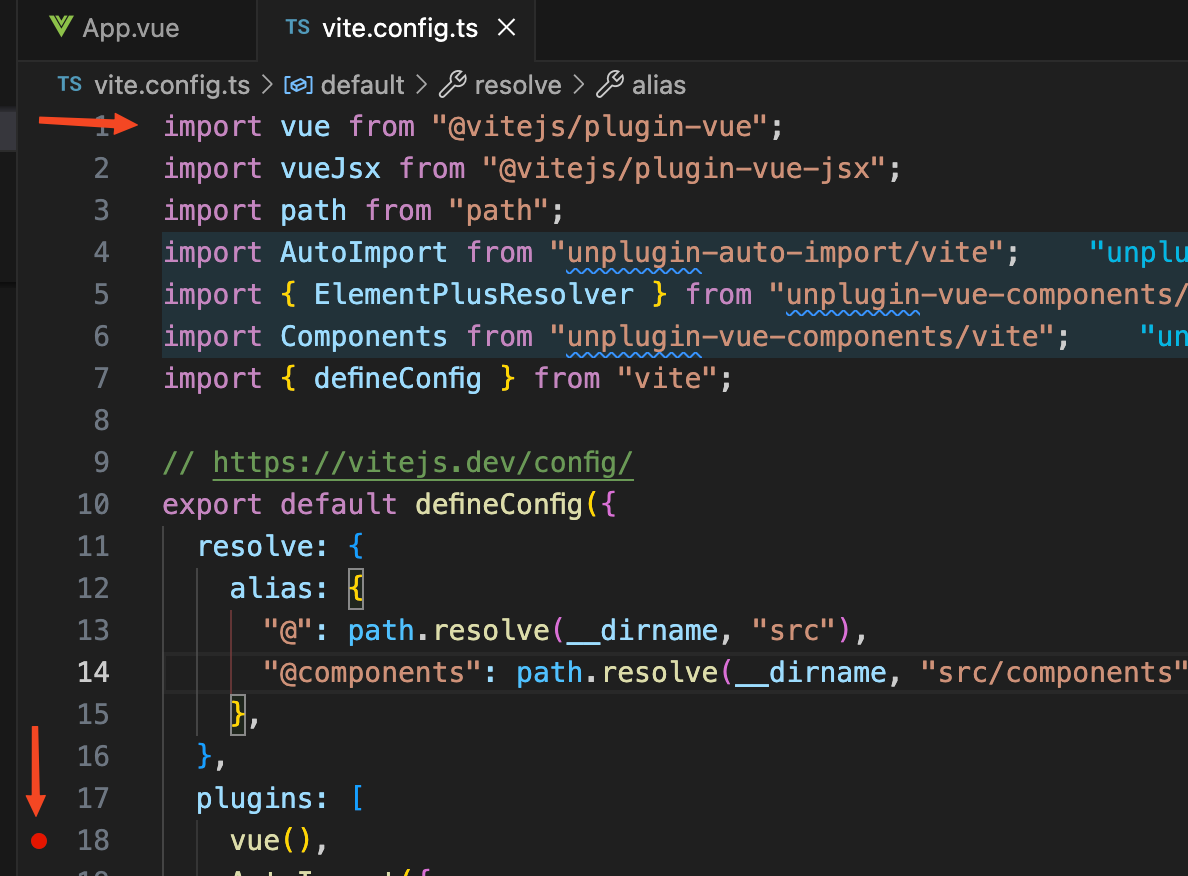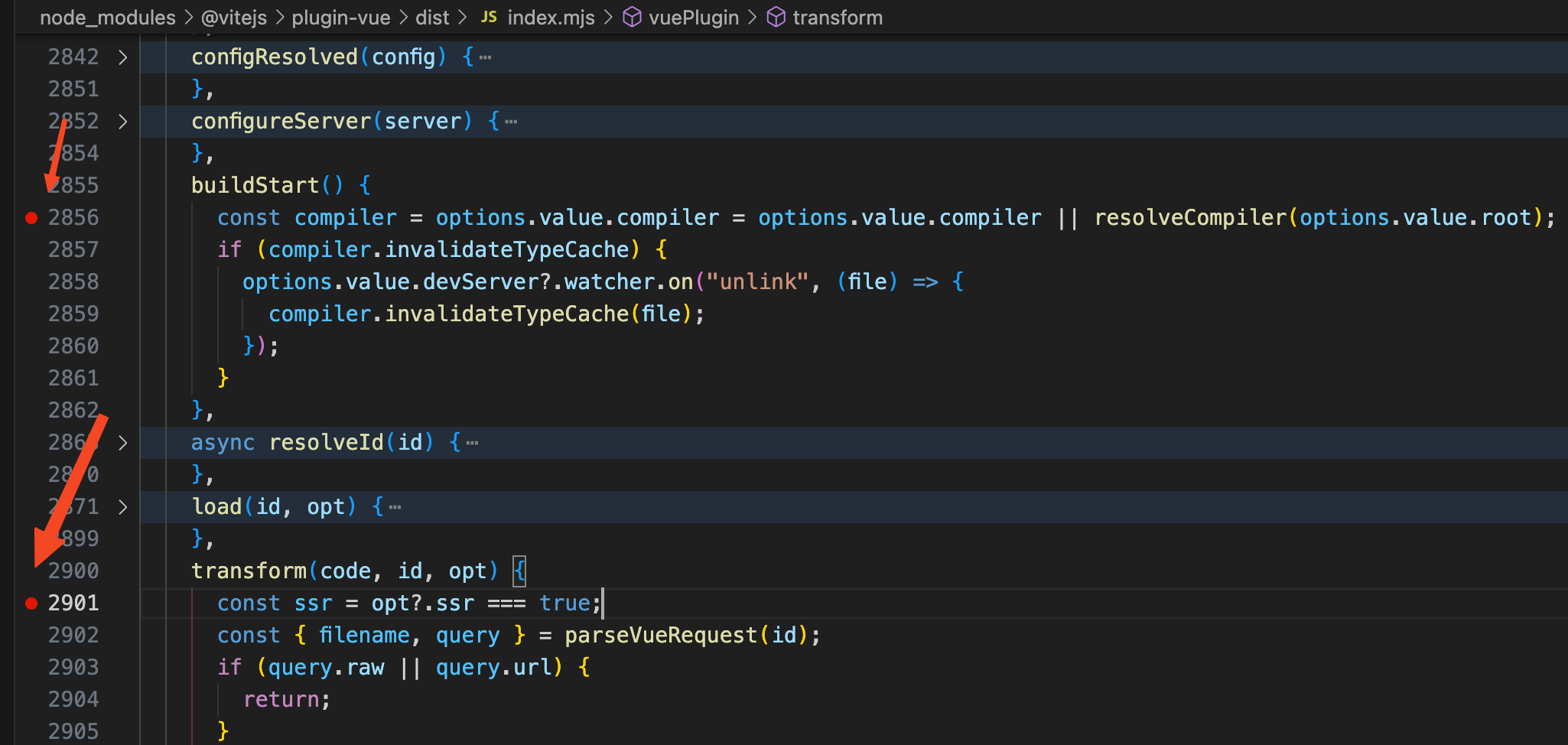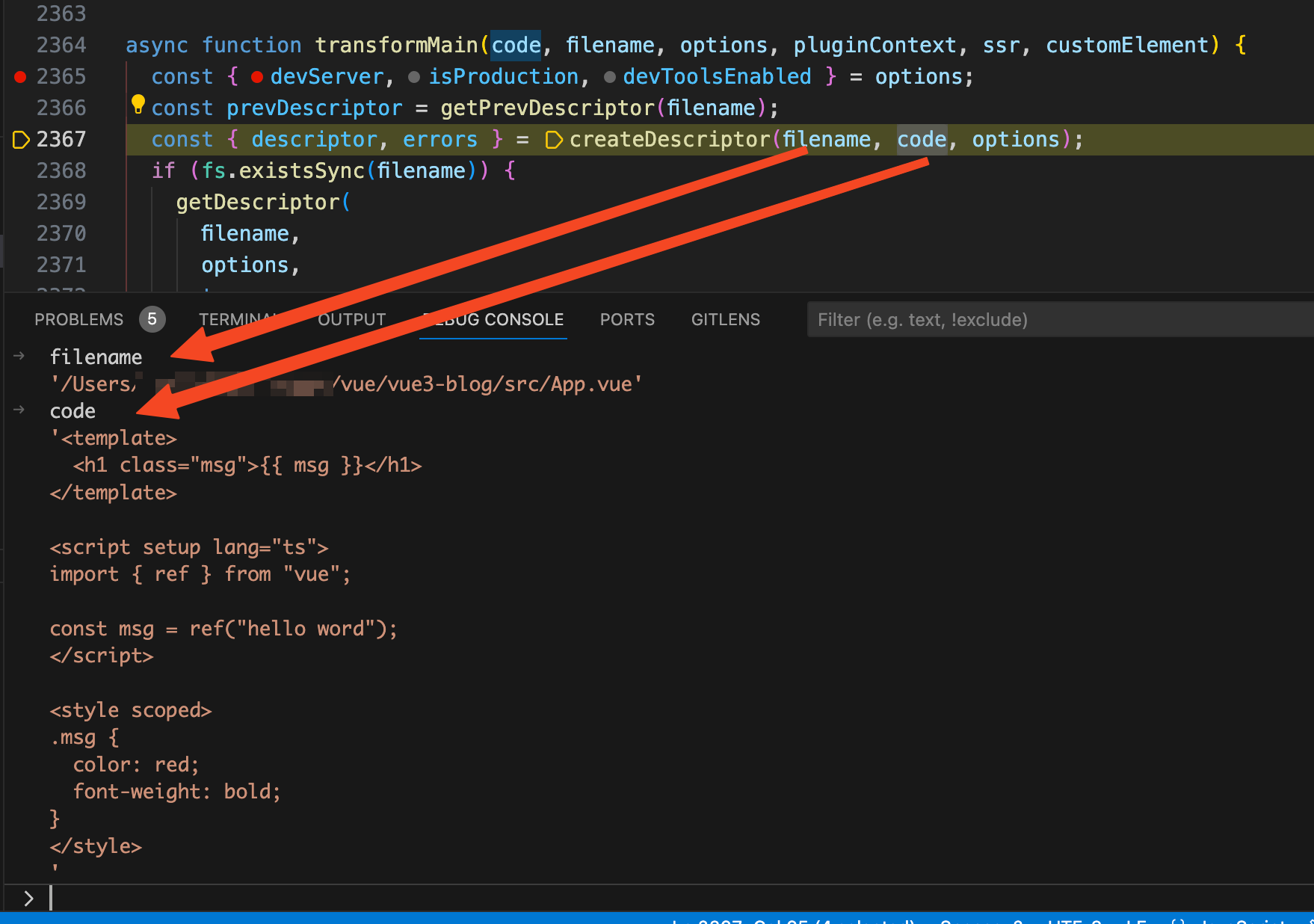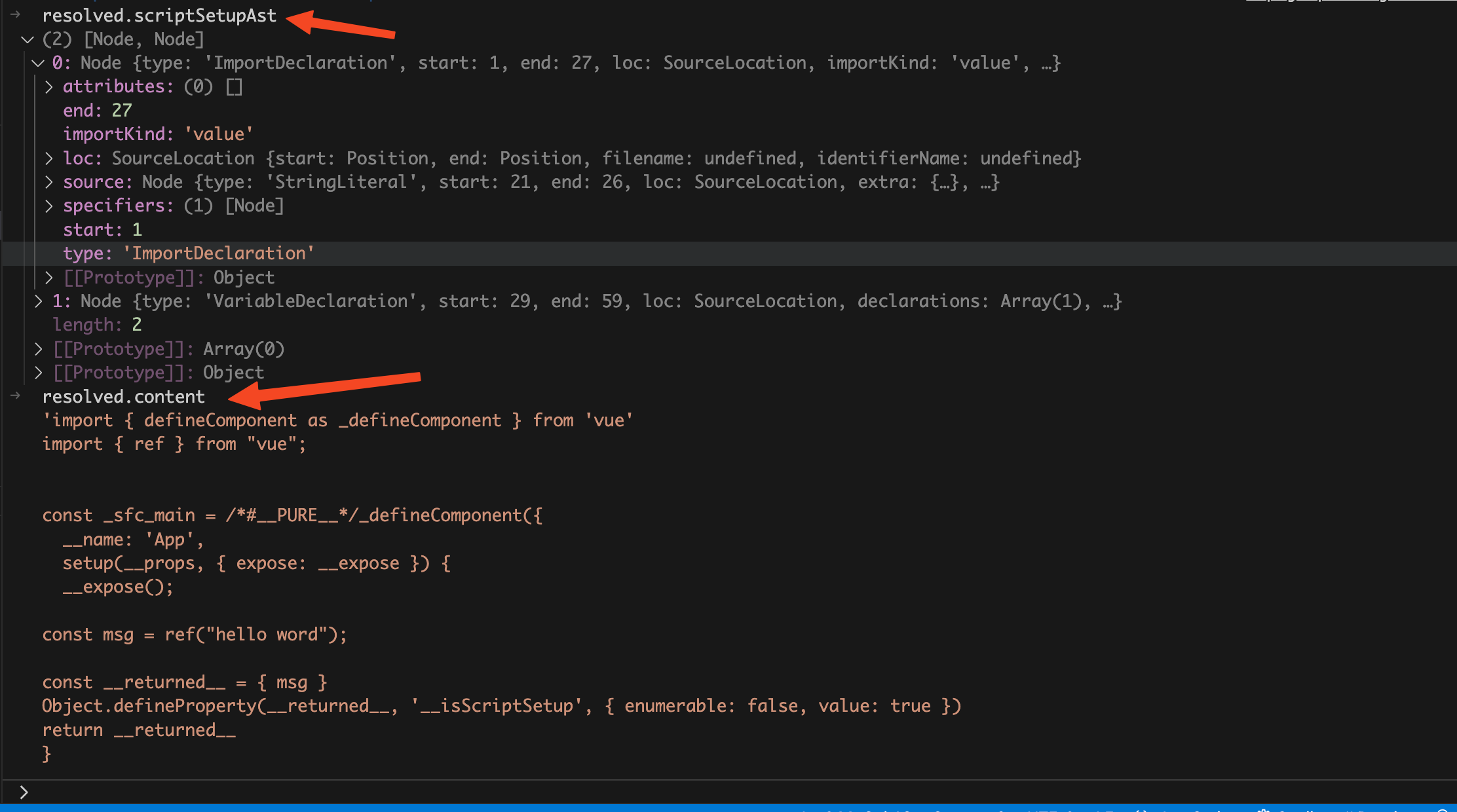前言 我們每天寫的vue代碼都是寫在vue文件中,但是瀏覽器卻只認識html、css、js等文件類型。所以這個時候就需要一個工具將vue文件轉換為瀏覽器能夠認識的js文件,想必你第一時間就想到了webpack或者vite。但是webpack和vite本身是沒有能力處理vue文件的,其實實際背後生效的 ...
前言
我們每天寫的vue代碼都是寫在vue文件中,但是瀏覽器卻只認識html、css、js等文件類型。所以這個時候就需要一個工具將vue文件轉換為瀏覽器能夠認識的js文件,想必你第一時間就想到了webpack或者vite。但是webpack和vite本身是沒有能力處理vue文件的,其實實際背後生效的是vue-loader和@vitejs/plugin-vue。本文以@vitejs/plugin-vue舉例,通過debug的方式帶你一步一步的搞清楚vue文件是如何編譯為js文件的,看不懂你來打我。
舉個例子
這個是我的源代碼App.vue文件:
<template>
<h1 class="msg">{{ msg }}</h1>
</template>
<script setup lang="ts">
import { ref } from "vue";
const msg = ref("hello word");
</script>
<style scoped>
.msg {
color: red;
font-weight: bold;
}
</style>
這個例子很簡單,在setup中定義了msg變數,然後在template中將msg渲染出來。
下麵這個是我從network中找到的編譯後的js文件,已經精簡過了:
import {
createElementBlock as _createElementBlock,
defineComponent as _defineComponent,
openBlock as _openBlock,
toDisplayString as _toDisplayString,
ref,
} from "/node_modules/.vite/deps/vue.js?v=23bfe016";
import "/src/App.vue?vue&type=style&index=0&scoped=7a7a37b1&lang.css";
const _sfc_main = _defineComponent({
__name: "App",
setup(__props, { expose: __expose }) {
__expose();
const msg = ref("hello word");
const __returned__ = { msg };
return __returned__;
},
});
const _hoisted_1 = { class: "msg" };
function _sfc_render(_ctx, _cache, $props, $setup, $data, $options) {
return (
_openBlock(),
_createElementBlock(
"h1",
_hoisted_1,
_toDisplayString($setup.msg),
1
/* TEXT */
)
);
}
__sfc__.render = render;
export default _sfc_main;
編譯後的js代碼中我們可以看到主要有三部分,想必你也猜到了這三部分剛好對應vue文件的那三塊。
_sfc_main對象的setup方法對應vue文件中的<script setup lang="ts">模塊。_sfc_render函數對應vue文件中的<template>模塊。import "/src/App.vue?vue&type=style&index=0&scoped=7a7a37b1&lang.css";對應vue文件中的<style scoped>模塊。
debug搞清楚如何將vue文件編譯為js文件
大家應該都知道,前端代碼運行環境主要有兩個,node端和瀏覽器端,分別對應我們熟悉的編譯時和運行時。瀏覽器明顯是不認識vue文件的,所以vue文件編譯成js這一過程肯定不是在運行時的瀏覽器端。很明顯這一過程是在編譯時的node端。
要在node端打斷點,我們需要啟動一個debug 終端。這裡以vscode舉例,首先我們需要打開終端,然後點擊終端中的+號旁邊的下拉箭頭,在下拉中點擊Javascript Debug Terminal就可以啟動一個debug終端。

假如vue文件編譯為js文件是一個毛線團,那麼他的線頭一定是vite.config.ts文件中使用@vitejs/plugin-vue的地方。通過這個線頭開始debug我們就能夠梳理清楚完整的工作流程。

vuePlugin函數
我們給上方圖片的vue函數打了一個斷點,然後在debug終端上面執行yarn dev,我們看到斷點已經停留在了vue函數這裡。然後點擊step into,斷點走到了@vitejs/plugin-vue庫中的一個vuePlugin函數中。我們看到vuePlugin函數中的內容代碼大概是這樣的:
function vuePlugin(rawOptions = {}) {
const options = shallowRef({
compiler: null,
// 省略...
});
return {
name: "vite:vue",
handleHotUpdate(ctx) {
// ...
},
config(config) {
// ..
},
configResolved(config) {
// ..
},
configureServer(server) {
// ..
},
buildStart() {
// ..
},
async resolveId(id) {
// ..
},
load(id, opt) {
// ..
},
transform(code, id, opt) {
// ..
}
};
}
@vitejs/plugin-vue是作為一個plugins插件在vite中使用,vuePlugin函數返回的對象中的buildStart、transform方法就是對應的插件鉤子函數。vite會在對應的時候調用這些插件的鉤子函數,比如當vite伺服器啟動時就會調用插件裡面的buildStart等函數,當vite解析每個模塊時就會調用transform等函數。更多vite鉤子相關內容查看官網。
我們這裡主要看buildStart和transform兩個鉤子函數,分別是伺服器啟動時調用和解析每個模塊時調用。給這兩個鉤子函數打上斷點。

然後點擊Continue(F5),vite服務啟動後就會走到buildStart鉤子函數中打的斷點。我們可以看到buildStart鉤子函數的代碼是這樣的:
buildStart() {
const compiler = options.value.compiler = options.value.compiler || resolveCompiler(options.value.root);
}
將滑鼠放到options.value.compiler上面我們看到此時options.value.compiler的值為null,所以代碼會走到resolveCompiler函數中,點擊Step Into(F11)走到resolveCompiler函數中。看到resolveCompiler函數代碼如下:
function resolveCompiler(root) {
const compiler = tryResolveCompiler(root) || tryResolveCompiler();
return compiler;
}
function tryResolveCompiler(root) {
const vueMeta = tryRequire("vue/package.json", root);
if (vueMeta && vueMeta.version.split(".")[0] >= 3) {
return tryRequire("vue/compiler-sfc", root);
}
}
在resolveCompiler函數中調用了tryResolveCompiler函數,在tryResolveCompiler函數中判斷當前項目是否是vue3.x版本,然後將vue/compiler-sfc包返回。所以經過初始化後options.value.compiler的值就是vue的底層庫vue/compiler-sfc,記住這個後面會用。
然後點擊Continue(F5)放掉斷點,在瀏覽器中打開對應的頁面,比如:http://localhost:5173/ 。此時vite將會編譯這個頁面要用到的所有文件,就會走到transform鉤子函數斷點中了。由於解析每個文件都會走到transform鉤子函數中,但是我們只關註App.vue文件是如何解析的,所以為了方便我們直接在transform函數中添加了下麵這段代碼,並且刪掉了原來在transform鉤子函數中打的斷點,這樣就只有解析到App.vue文件的時候才會走到斷點中去。

經過debug我們發現解析App.vue文件時transform函數實際就是執行了transformMain函數,至於transformStyle函數後面講解析style的時候會講:
transform(code, id, opt) {
const { filename, query } = parseVueRequest(id);
if (!query.vue) {
return transformMain(
code,
filename,
options.value,
this,
ssr,
customElementFilter.value(filename)
);
} else {
const descriptor = query.src ? getSrcDescriptor(filename, query) || getTempSrcDescriptor(filename, query) : getDescriptor(filename, options.value);
if (query.type === "style") {
return transformStyle(
code,
descriptor,
Number(query.index || 0),
options.value,
this,
filename
);
}
}
}
transformMain函數
繼續debug斷點走進transformMain函數,發現transformMain函數中代碼邏輯很清晰。按照順序分別是:
- 根據源代碼code字元串調用
createDescriptor函數生成一個descriptor對象。 - 調用
genScriptCode函數傳入第一步生成的descriptor對象將<script setup>模塊編譯為瀏覽器可執行的js代碼。 - 調用
genTemplateCode函數傳入第一步生成的descriptor對象將<template>模塊編譯為render函數。 - 調用
genStyleCode函數傳入第一步生成的descriptor對象將<style scoped>模塊編譯為類似這樣的import語句,import "/src/App.vue?vue&type=style&index=0&scoped=7a7a37b1&lang.css";。
createDescriptor函數
我們先來看看createDescriptor函數,將斷點走到createDescriptor(filename, code, options)這一行代碼,可以看到傳入的filename就是App.vue的文件路徑,code就是App.vue中我們寫的源代碼。

debug走進createDescriptor函數,看到createDescriptor函數的代碼如下:
function createDescriptor(filename, source, { root, isProduction, sourceMap, compiler, template }, hmr = false) {
const { descriptor, errors } = compiler.parse(source, {
filename,
sourceMap,
templateParseOptions: template?.compilerOptions
});
const normalizedPath = slash(path.normalize(path.relative(root, filename)));
descriptor.id = getHash(normalizedPath + (isProduction ? source : ""));
return { descriptor, errors };
}
這個compiler是不是覺得有點熟悉?compiler是調用createDescriptor函數時傳入的第三個參數解構而來,而第三個參數就是options。還記得我們之前在vite啟動時調用了buildStart鉤子函數,然後將vue底層包vue/compiler-sfc賦值給options的compiler屬性。那這裡的compiler.parse其實就是調用的vue/compiler-sfc包暴露出來的parse函數,這是一個vue暴露出來的底層的API,這篇文章我們不會對底層API進行源碼解析,通過查看parse函數的輸入和輸出基本就可以搞清楚parse函數的作用。下麵這個是parse函數的類型定義:
export function parse(
source: string,
options: SFCParseOptions = {},
): SFCParseResult {}
從上面我們可以看到parse函數接收兩個參數,第一個參數為vue文件的源代碼,在我們這裡就是App.vue中的code字元串,第二個參數是一些options選項。
我們再來看看parse函數的返回值SFCParseResult,主要有類型為SFCDescriptor的descriptor屬性需要關註。
export interface SFCParseResult {
descriptor: SFCDescriptor
errors: (CompilerError | SyntaxError)[]
}
export interface SFCDescriptor {
filename: string
source: string
template: SFCTemplateBlock | null
script: SFCScriptBlock | null
scriptSetup: SFCScriptBlock | null
styles: SFCStyleBlock[]
customBlocks: SFCBlock[]
cssVars: string[]
slotted: boolean
shouldForceReload: (prevImports: Record<string, ImportBinding>) => boolean
}
仔細看看SFCDescriptor類型,其中的template屬性就是App.vue文件對應的template標簽中的內容,裡面包含了由App.vue文件中的template模塊編譯成的AST抽象語法樹和原始的template中的代碼。

我們再來看script和scriptSetup屬性,由於vue文件中可以寫多個script標簽,scriptSetup對應的就是有setup的script標簽,script對應的就是沒有setup對應的script標簽。我們這個場景中只有scriptSetup屬性,裡面同樣包含了App.vue中的script模塊中的內容。

我們再來看看styles屬性,這裡的styles屬性是一個數組,是因為我們可以在vue文件中寫多個style模塊,裡面同樣包含了App.vue中的style模塊中的內容。

所以這一步執行createDescriptor函數生成的descriptor對象中主要有三個屬性,template屬性包含了App.vue文件中的template模塊code字元串和AST抽象語法樹,scriptSetup屬性包含了App.vue文件中的<script setup>模塊的code字元串,styles屬性包含了App.vue文件中<style>模塊中的code字元串。createDescriptor函數的執行流程圖如下:

genScriptCode函數
我們再來看genScriptCode函數是如何將<script setup>模塊編譯成可執行的js代碼,同樣將斷點走到調用genScriptCode函數的地方,genScriptCode函數主要接收我們上一步生成的descriptor對象,調用genScriptCode函數後會將編譯後的script模塊代碼賦值給scriptCode變數。
const { code: scriptCode, map: scriptMap } = await genScriptCode(
descriptor,
options,
pluginContext,
ssr,
customElement
);
將斷點走到genScriptCode函數內部,在genScriptCode函數中主要就是這行代碼: const script = resolveScript(descriptor, options, ssr, customElement);。將第一步生成的descriptor對象作為參數傳給resolveScript函數,返回值就是編譯後的js代碼,genScriptCode函數的代碼簡化後如下:
async function genScriptCode(descriptor, options, pluginContext, ssr, customElement) {
let scriptCode = `const ${scriptIdentifier} = {}`;
const script = resolveScript(descriptor, options, ssr, customElement);
if (script) {
scriptCode = script.content;
map = script.map;
}
return {
code: scriptCode,
map
};
}
我們繼續將斷點走到resolveScript函數內部,發現resolveScript中的代碼其實也很簡單,簡化後的代碼如下:
function resolveScript(descriptor, options, ssr, customElement) {
let resolved = null;
resolved = options.compiler.compileScript(descriptor, {
...options.script,
id: descriptor.id,
isProd: options.isProduction,
inlineTemplate: isUseInlineTemplate(descriptor, !options.devServer),
templateOptions: resolveTemplateCompilerOptions(descriptor, options, ssr),
sourceMap: options.sourceMap,
genDefaultAs: canInlineMain(descriptor, options) ? scriptIdentifier : void 0,
customElement
});
return resolved;
}
這裡的options.compiler我們前面第一步的時候已經解釋過了,options.compiler對象實際就是vue底層包vue/compiler-sfc暴露的對象,這裡的options.compiler.compileScript()其實就是調用的vue/compiler-sfc包暴露出來的compileScript函數,同樣也是一個vue暴露出來的底層的API,後面我們的分析defineOptions等文章時會去深入分析compileScript函數,這篇文章我們不會去讀compileScript函數的源碼。通過查看compileScript函數的輸入和輸出基本就可以搞清楚compileScript函數的作用。下麵這個是compileScript函數的類型定義:
export function compileScript(
sfc: SFCDescriptor,
options: SFCScriptCompileOptions,
): SFCScriptBlock{}
這個函數的入參是一個SFCDescriptor對象,就是我們第一步調用生成createDescriptor函數生成的descriptor對象,第二個參數是一些options選項。我們再來看返回值SFCScriptBlock類型:
export interface SFCScriptBlock extends SFCBlock {
type: 'script'
setup?: string | boolean
bindings?: BindingMetadata
imports?: Record<string, ImportBinding>
scriptAst?: import('@babel/types').Statement[]
scriptSetupAst?: import('@babel/types').Statement[]
warnings?: string[]
/**
* Fully resolved dependency file paths (unix slashes) with imported types
* used in macros, used for HMR cache busting in @vitejs/plugin-vue and
* vue-loader.
*/
deps?: string[]
}
export interface SFCBlock {
type: string
content: string
attrs: Record<string, string | true>
loc: SourceLocation
map?: RawSourceMap
lang?: string
src?: string
}
返回值類型中主要有scriptAst、scriptSetupAst、content這三個屬性,scriptAst為編譯不帶setup屬性的script標簽生成的AST抽象語法樹。scriptSetupAst為編譯帶setup屬性的script標簽生成的AST抽象語法樹,content為vue文件中的script模塊編譯後生成的瀏覽器可執行的js代碼。下麵這個是執行vue/compiler-sfc的compileScript函數返回結果:

繼續將斷點走回genScriptCode函數,現在邏輯就很清晰了。這裡的script對象就是調用vue/compiler-sfc的compileScript函數返回對象,scriptCode就是script對象的content屬性 ,也就是將vue文件中的script模塊經過編譯後生成瀏覽器可直接執行的js代碼code字元串。
async function genScriptCode(descriptor, options, pluginContext, ssr, customElement) {
let scriptCode = `const ${scriptIdentifier} = {}`;
const script = resolveScript(descriptor, options, ssr, customElement);
if (script) {
scriptCode = script.content;
map = script.map;
}
return {
code: scriptCode,
map
};
}
genScriptCode函數的執行流程圖如下:

genTemplateCode函數
我們再來看genTemplateCode函數是如何將template模塊編譯成render函數的,同樣將斷點走到調用genTemplateCode函數的地方,genTemplateCode函數主要接收我們上一步生成的descriptor對象,調用genTemplateCode函數後會將編譯後的template模塊代碼賦值給templateCode變數。
({ code: templateCode, map: templateMap } = await genTemplateCode(
descriptor,
options,
pluginContext,
ssr,
customElement
))
同樣將斷點走到genTemplateCode函數內部,在genTemplateCode函數中主要就是返回transformTemplateInMain函數的返回值,genTemplateCode函數的代碼簡化後如下:
async function genTemplateCode(descriptor, options, pluginContext, ssr, customElement) {
const template = descriptor.template;
return transformTemplateInMain(
template.content,
descriptor,
options,
pluginContext,
ssr,
customElement
);
}
我們繼續將斷點走進transformTemplateInMain函數,發現這裡也主要是調用compile函數,代碼如下:
function transformTemplateInMain(code, descriptor, options, pluginContext, ssr, customElement) {
const result = compile(
code,
descriptor,
options,
pluginContext,
ssr,
customElement
);
return {
...result,
code: result.code.replace(
/\nexport (function|const) (render|ssrRender)/,
"\n$1 _sfc_$2"
)
};
}
同理將斷點走進到compile函數內部,我們看到compile函數的代碼是下麵這樣的:
function compile(code, descriptor, options, pluginContext, ssr, customElement) {
const result = options.compiler.compileTemplate({
...resolveTemplateCompilerOptions(descriptor, options, ssr),
source: code
});
return result;
}
同樣這裡也用到了options.compiler,調用options.compiler.compileTemplate()其實就是調用的vue/compiler-sfc包暴露出來的compileTemplate函數,這也是一個vue暴露出來的底層的API。不過這裡和前面不同的是compileTemplate接收的不是descriptor對象,而是一個SFCTemplateCompileOptions類型的對象,所以這裡需要調用resolveTemplateCompilerOptions函數將參數轉換成SFCTemplateCompileOptions類型的對象。這篇文章我們不會對底層API進行解析。通過查看compileTemplate函數的輸入和輸出基本就可以搞清楚compileTemplate函數的作用。下麵這個是compileTemplate函數的類型定義:
export function compileTemplate(
options: SFCTemplateCompileOptions,
): SFCTemplateCompileResults {}
入參options主要就是需要編譯的template中的源代碼和對應的AST抽象語法樹。我們來看看返回值SFCTemplateCompileResults,這裡面的code就是編譯後的render函數字元串。
export interface SFCTemplateCompileResults {
code: string
ast?: RootNode
preamble?: string
source: string
tips: string[]
errors: (string | CompilerError)[]
map?: RawSourceMap
}

genTemplateCode函數的執行流程圖如下:

genStyleCode函數
我們再來看最後一個genStyleCode函數,同樣將斷點走到調用genStyleCode的地方。一樣的接收descriptor對象。代碼如下:
const stylesCode = await genStyleCode(
descriptor,
pluginContext,
customElement,
attachedProps
);
我們將斷點走進genStyleCode函數內部,發現和前面genScriptCode和genTemplateCode函數有點不一樣,下麵這個是我簡化後的genStyleCode函數代碼:
async function genStyleCode(descriptor, pluginContext, customElement, attachedProps) {
let stylesCode = ``;
if (descriptor.styles.length) {
for (let i = 0; i < descriptor.styles.length; i++) {
const style = descriptor.styles[i];
const src = style.src || descriptor.filename;
const attrsQuery = attrsToQuery(style.attrs, "css");
const srcQuery = style.src ? style.scoped ? `&src=${descriptor.id}` : "&src=true" : "";
const directQuery = customElement ? `&inline` : ``;
const scopedQuery = style.scoped ? `&scoped=${descriptor.id}` : ``;
const query = `?vue&type=style&index=${i}${srcQuery}${directQuery}${scopedQuery}`;
const styleRequest = src + query + attrsQuery;
stylesCode += `
import ${JSON.stringify(styleRequest)}`;
}
}
return stylesCode;
}
我們前面講過因為vue文件中可能會有多個style標簽,所以descriptor對象的styles屬性是一個數組。遍歷descriptor.styles數組,我們發現for迴圈內全部都是一堆賦值操作,沒有調用vue/compiler-sfc包暴露出來的任何API。將斷點走到 return stylesCode;,看看stylesCode到底是什麼東西?

通過列印我們發現stylesCode竟然變成了一條import語句,並且import的還是當前App.vue文件,只是多了幾個query分別是:vue、type、index、scoped、lang。再來回憶一下前面講的@vitejs/plugin-vue的transform鉤子函數,當vite解析每個模塊時就會調用transform等函數。所以當代碼運行到這行import語句的時候會再次走到transform鉤子函數中。我們再來看看transform鉤子函數的代碼:
transform(code, id, opt) {
const { filename, query } = parseVueRequest(id);
if (!query.vue) {
// 省略
} else {
const descriptor = query.src ? getSrcDescriptor(filename, query) || getTempSrcDescriptor(filename, query) : getDescriptor(filename, options.value);
if (query.type === "style") {
return transformStyle(
code,
descriptor,
Number(query.index || 0),
options.value,
this,
filename
);
}
}
}
當query中有vue欄位,並且query中type欄位值為style時就會執行transformStyle函數,我們給transformStyle函數打個斷點。當執行上面那條import語句時就會走到斷點中,我們進到transformStyle中看看。
async function transformStyle(code, descriptor, index, options, pluginContext, filename) {
const block = descriptor.styles[index];
const result = await options.compiler.compileStyleAsync({
...options.style,
filename: descriptor.filename,
id: `data-v-${descriptor.id}`,
isProd: options.isProduction,
source: code,
scoped: block.scoped,
...options.cssDevSourcemap ? {
postcssOptions: {
map: {
from: filename,
inline: false,
annotation: false
}
}
} : {}
});
return {
code: result.code,
map
};
}
transformStyle函數的實現我們看著就很熟悉了,和前面處理template和script一樣都是調用的vue/compiler-sfc包暴露出來的compileStyleAsync函數,這也是一個vue暴露出來的底層的API。同樣我們不會對底層API進行解析。通過查看compileStyleAsync函數的輸入和輸出基本就可以搞清楚compileStyleAsync函數的作用。
export function compileStyleAsync(
options: SFCAsyncStyleCompileOptions,
): Promise<SFCStyleCompileResults> {}
我們先來看看SFCAsyncStyleCompileOptions入參:
interface SFCAsyncStyleCompileOptions extends SFCStyleCompileOptions {
isAsync?: boolean
modules?: boolean
modulesOptions?: CSSModulesOptions
}
interface SFCStyleCompileOptions {
source: string
filename: string
id: string
scoped?: boolean
trim?: boolean
isProd?: boolean
inMap?: RawSourceMap
preprocessLang?: PreprocessLang
preprocessOptions?: any
preprocessCustomRequire?: (id: string) => any
postcssOptions?: any
postcssPlugins?: any[]
map?: RawSourceMap
}
入參主要關註幾個欄位,source欄位為style標簽中的css原始代碼。scoped欄位為style標簽中是否有scoped attribute。id欄位為我們在觀察 DOM 結構時看到的 data-v-xxxxx。這個是debug時入參截圖:

再來看看返回值SFCStyleCompileResults對象,主要就是code屬性,這個是經過編譯後的css字元串,已經加上了data-v-xxxxx。
interface SFCStyleCompileResults {
code: string
map: RawSourceMap | undefined
rawResult: Result | LazyResult | undefined
errors: Error[]
modules?: Record<string, string>
dependencies: Set<string>
}
這個是debug時compileStyleAsync函數返回值的截圖:

genStyleCode函數的執行流程圖如下:

transformMain函數簡化後的代碼
現在我們可以來看transformMain函數簡化後的代碼:
async function transformMain(code, filename, options, pluginContext, ssr, customElement) {
const { descriptor, errors } = createDescriptor(filename, code, options);
const { code: scriptCode, map: scriptMap } = await genScriptCode(
descriptor,
options,
pluginContext,
ssr,
customElement
);
let templateCode = "";
({ code: templateCode, map: templateMap } = await genTemplateCode(
descriptor,
options,
pluginContext,
ssr,
customElement
));
const stylesCode = await genStyleCode(
descriptor,
pluginContext,
customElement,
attachedProps
);
const output = [
scriptCode,
templateCode,
stylesCode
];
let resolvedCode = output.join("\n");
return {
code: resolvedCode,
map: resolvedMap || {
mappings: ""
},
meta: {
vite: {
lang: descriptor.script?.lang || descriptor.scriptSetup?.lang || "js"
}
}
};
}
transformMain函數中的代碼執行主流程,其實就是對應了一個vue文件編譯成js文件的流程。
首先調用createDescriptor函數將一個vue文件解析為一個descriptor對象。
然後以descriptor對象為參數調用genScriptCode函數,將vue文件中的<script>模塊代碼編譯成瀏覽器可執行的js代碼code字元串,賦值給scriptCode變數。
接著以descriptor對象為參數調用genTemplateCode函數,將vue文件中的<template>模塊代碼編譯成render函數code字元串,賦值給templateCode變數。
然後以descriptor對象為參數調用genStyleCode函數,將vue文件中的<style>模塊代碼編譯成了import語句code字元串,比如:import "/src/App.vue?vue&type=style&index=0&scoped=7a7a37b1&lang.css";,賦值給stylesCode變數。
然後將scriptCode、templateCode、stylesCode使用換行符\n拼接起來得到resolvedCode,這個resolvedCode就是一個vue文件編譯成js文件的代碼code字元串。這個是debug時resolvedCode變數值的截圖:

總結
這篇文章通過debug的方式一步一步的帶你瞭解vue文件編譯成js文件的完整流程,下麵是一個完整的流程圖。如果文字太小看不清,可以將圖片保存下來或者放大看:

@vitejs/plugin-vue-jsx庫中有個叫transform的鉤子函數,每當vite載入模塊的時候就會觸發這個鉤子函數。所以當import一個vue文件的時候,就會走到@vitejs/plugin-vue-jsx中的transform鉤子函數中,在transform鉤子函數中主要調用了transformMain函數。
第一次解析這個vue文件時,在transform鉤子函數中主要調用了transformMain函數。在transformMain函數中主要調用了4個函數,分別是:createDescriptor、genScriptCode、genTemplateCode、genStyleCode。
createDescriptor接收的參數為當前vue文件代碼code字元串,返回值為一個descriptor對象。對象中主要有四個屬性template、scriptSetup、script、styles。
descriptor.template.ast就是由vue文件中的template模塊生成的AST抽象語法樹。descriptor.template.content就是vue文件中的template模塊的代碼字元串。scriptSetup和script的區別是分別對應的是vue文件中有setup屬性的<script>模塊和無setup屬性的<script>模塊。descriptor.scriptSetup.content就是vue文件中的<script setup>模塊的代碼字元串。
genScriptCode函數為底層調用vue/compiler-sfc的compileScript函數,根據第一步的descriptor對象將vue文件的<script setup>模塊轉換為瀏覽器可直接執行的js代碼。
genTemplateCode函數為底層調用vue/compiler-sfc的compileTemplate函數,根據第一步的descriptor對象將vue文件的<template>模塊轉換為render函數。
genStyleCode函數為將vue文件的style模塊轉換為import "/src/App.vue?vue&type=style&index=0&scoped=7a7a37b1&lang.css";樣子的import語句。
然後使用換行符\n將genScriptCode函數、genTemplateCode函數、genStyleCode函數的返回值拼接起來賦值給變數resolvedCode,這個resolvedCode就是vue文件編譯成js文件的code字元串。
當瀏覽器執行到import "/src/App.vue?vue&type=style&index=0&scoped=7a7a37b1&lang.css";語句時,觸發了載入模塊操作,再次觸發了@vitejs/plugin-vue-jsx中的transform鉤子函數。此時由於有了type=style的query,所以在transform函數中會執行transformStyle函數,在transformStyle函數中同樣也是調用vue/compiler-sfc的compileStyleAsync函數,根據第一步的descriptor對象將vue文件的<style>模塊轉換為編譯後的css代碼code字元串,至此編譯style部分也講完了。
關註公眾號:前端歐陽,解鎖我更多vue乾貨文章,並且可以免費向我咨詢vue相關問題。



